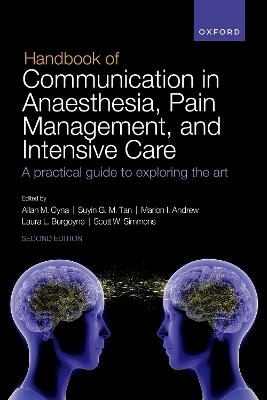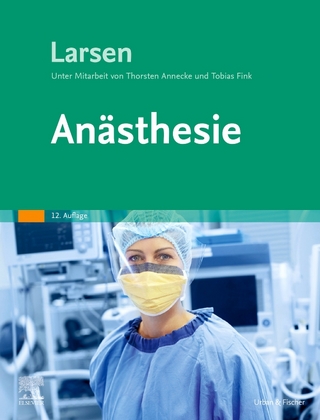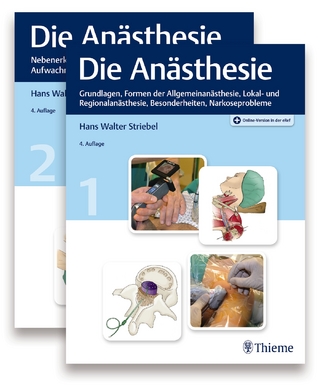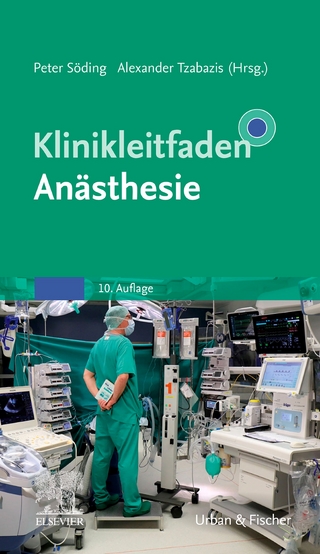
Handbook of Communication in Anaesthesia, Pain Management, and Intensive Care
Oxford University Press (Verlag)
978-0-19-885866-9 (ISBN)
Communication in anaesthesia, pain management, and intensive care can have profound impacts on patients and healthcare colleagues. Good communication can result in better patient outcomes and experiences of the hospital setting, whereas poor communication is frequently at the heart of adverse incidents, complaints, and litigation.
This handbook outlines two model frameworks to improve communication: one to give structure to an interaction and one that explores language structures and the layers of meaning to our words. The frameworks are essential tools for communicating with children, obstetric patients, and those with needle phobia.
A practical guide, the book is packed with useful tips to enhance interactions with both patients and colleagues. Numerous examples and vignettes clearly demonstrate ideas that will improve patient care, safety, and bring out the best in everyone around.
Fully updated with new clinical guidelines and literature, the second edition includes new chapters on how to talk to patients in pain, featuring motivational interviewing techniques, and on social media. Increased coverage of managing challenging situations, includes communicating with distressed relatives, dealing with complaints, and working with interpreters.
The contributors and editors are senior clinicians from North America, Europe, and Australasia, working at the coalface of perioperative and critical care. Blending theory, science, and practicality, this book complements resources for communication skills teaching in anaesthesia and other related professional groups.
Dr Allan M Cyna initially trained in the UK as a GP and subsequently in anaesthesia. He has developed a special interest in clinical hypnosis as an anaesthesia adjunct whilst working as a Senior Consultant Anaesthetist at the Women's and Children's Hospital in Adelaide - particularly in paediatric burns and the Obstetric population. Dr Suyin GM Tan is a specialist anaesthetist and pain management physician with over 35 years clinical experience. She completed her training in the UK prior to emigrating to Australia. She has spent most of her professional career working at Nepean Hospital Sydney. Her research interests focus on communication and pain. Her clinical interests include non pharmacological management of pain, non technical skills in anaesthesia and improving access to care in regional communities. She regularly contributes to local and national meetings. Dr Marion I Andrew has been specialist anaesthetist, and worked in the obstetrics and paediatric departments at the Women's and Children's Hospital in South Australia between 1996 and 2023. She has Diploma in Clinical Hypnosis currently works as a clinical hypnotherapist and communication educator. She is studying for a bachelor of science at the University of Adelaide. Dr Laura L Burgoyne is a paediatric anaesthetist at the Women's and Children's Hospital, Adelaide, Australia. She has also has worked in Oxford, England and St Jude Children's Research Hospital in Memphis, USA. Laura has published extensively in paediatric pain and anaesthesia, is a College Examiner and has an interest in effecting clinical change in complex hospital systems. Dr Scott W Simmons is a retired consultant anaesthetist with more than thirty years of experience as clinician, researcher, senior health service administrator, and mentor. His particular interests have been the application of best evidence in clinical practice, critical incident investigation and system-based improvement, clinical audit, and care pathway implementation.
Section I Principles of communication
1: Introduction
2: Structures
3: How words hurt
4: Language and the subconscious
5: Narrative and metaphor in anaesthesia
Section 2 Routine clinical applications
6: The pre-operative visit
7: Consent
8: Perioperative care
9: Pain
Section 3 Specific clinical contexts
10: Pregnancy and childbirth
11: Children
12: Critical care
13: When bad things happen
14: Other challenges
15: Needle phobia
Section 4 Communication with colleagues
17: Safety-critical communication
18: The theatre team
19: Education
20: Research
21: Administrators
22: Media
Section 5 Advanced communication techniques
23: Hypnotic techniques
| Erscheinungsdatum | 10.09.2024 |
|---|---|
| Verlagsort | Oxford |
| Sprache | englisch |
| Maße | 157 x 235 mm |
| Gewicht | 502 g |
| Themenwelt | Medizin / Pharmazie ► Medizinische Fachgebiete ► Anästhesie |
| Medizin / Pharmazie ► Medizinische Fachgebiete ► Intensivmedizin | |
| Medizin / Pharmazie ► Medizinische Fachgebiete ► Medizinethik | |
| Medizin / Pharmazie ► Medizinische Fachgebiete ► Schmerztherapie | |
| ISBN-10 | 0-19-885866-3 / 0198858663 |
| ISBN-13 | 978-0-19-885866-9 / 9780198858669 |
| Zustand | Neuware |
| Haben Sie eine Frage zum Produkt? |
aus dem Bereich


